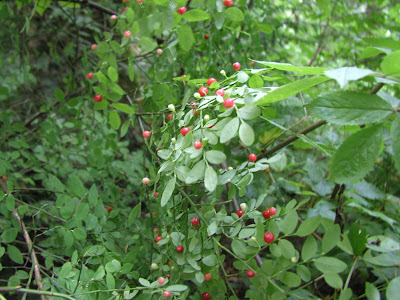
Been some while since having a GSF post, and figure starting them again away from the backyard and into the forest - the effortless garden - would be good, as I went there this evening.

There are five berries that I know of in these woods to forage: red huckleberry, osoberry, thimbleberry, salmon berry and blackberry. Salmon berry ripens first. They come in either pale yellow or dark red. Their taste tends to the insipid side, but are somehow still juicy and refreshing. This year there are lots of them and they're big and juicier than usual.
The osoberry is close behind salmon berry in ripening, suddenly all of them at once, and the red huckleberries ripen at the same time, but not all at once. Then the thimbleberries, with just a few fully ripened at this time. Blackberries don't ripen until later in summer.
The osoberry, or Indian plum:




The skin of them is thin and they want to stain your hands. They have pits and there is not a whole lot of meat, but they are very unique, and I find, pleasant in their taste. Some people say they taste like a cross between a blueberry and an olive. Honestly, I cannot think of a closer comparison.
They grow all over the woods in thickets. They hang in clusters that you pick entire as you walk by and eat them and spit out pits as you walk through the woods, until you come across another thicket and take another cluster, and so on.
The red huckleberry:


This one is my favourite. I like the green of the bush; I like how, with a few exceptions, it only grows out of rotting douglas fir stumps, or occasionally the base of living ones; I like the zingy, tart-sweet taste of the berries; I like the taste of its leaves, which I eat sometimes along with the berries.
The thimbleberry:





While the red huckleberry is my favourite all around, the thimbleberry is undeniably the richest in flavour. The taste to me is like a rich jam. The berries just melt in your mouth with a deep warm flavour. And not surprisingly, it is used to make prized jams, by people who jealously guard the secrets of their thimbleberry locations. There really is no need for that where I live, it's so common. Although the plant does have to have a prime location to make berries at their tastiest best.
One nice thing about picking the thimbleberry, as with all the other berries above, is that though it grows in thickets, they do not cut you apart like blackberries. In fact, the leaves feel like velvet - no exaggeration. And therein is a useful piece of information. I don't speak from experience, but it's common lore among wildcrafters that in case you are ever in the wild in those areas of North America where thimbleberry grows and you have to, uhm, you know, and then you have to, well, you know, then you can use the leaves for...you know. Anyhow! Of course with all berries, the ones that get the most light as well as adequate wet are the best tasting.

No comments:
Post a Comment